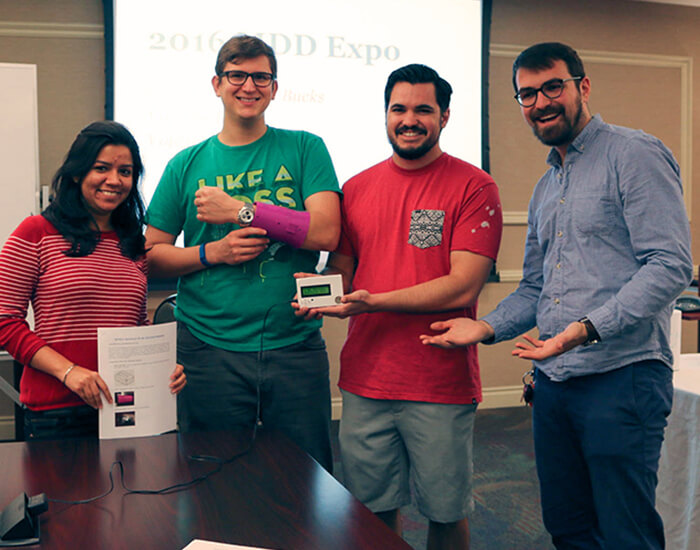On Thursday, May 5, students from the ALS 425: Device and Diagnostic Product Development class showcased the devices they designed and built during spring semester. The course, taught by Anna Hickerson, PhD, covers technical and managerial aspects involved in the development of medical devices and diagnostics through a combination of lectures, classroom labs, and a Team Design Project (TDP). Throughout the semester, students solved specific tasks from the perspective of a product manager, development engineer, industrial designer, or manufacturing engineer.
One of the major components of this course is a TDP, which provides students with an overview of general industry standards, quality systems, and certification processes. The project also leads students through preparation of a problem statement and product design specification, design and prototyping, testing, and design for manufacture and assembly. The project concludes with the preparation of a design master record.
The class is a valuable resource for students looking to gain meaningful and applied experience in product design and development. By course end, students are expected to be able to apply many topics learned, including: basic technical skills common to the design of medical devices and diagnostics such as data acquisition, associated hardware, and software processing; being able to discern the limitations and capabilities of common prototyping and manufacturing methods; and being able to specify appropriate quality and manufacturing standards for specific instrumentation types.
Anu Arora, an MBS '16 student, said: "The course gave us the opportunity to learn about different industry relevant processes through a hands-on device prototype development project. Designing 3D printed parts and brainstorming for the most user-friendly products were the most challenging as well as fun parts of the project." Arora's group developed BONES - Transcutaneous electrical stimulation paired with a 3D printed arm cast (mentioned below).
In order to showcase each group's product, the ALS 425 Product Development Expo was held. For the event, guests were welcome to ask questions as each group unveiled and demonstrated a final product. This year's expo included the following prototypes:
- Therapeutic Boot - detection and vibrational warning system for use with therapeutic boot
- iBreathe- discrete breathalyzer in the shape of lipstick
- BONES - transcutaneous electrical stimulation paired with 3D printed arm cast
- Thermofectometer - non-instrumented wound infection detection in the form of a bandage
- Infection Monitoring System (IMS) - Active temperature based wound-infection monitor
Speaking about the expo, Hickerson said: "The MDD expo is a fun and interactive way for the students to showcase the devices they developed during the semester. In addition to building the devices, the students stepped through the product development process including all the necessary documentation, some of which includes product specifications, testing and failure modes analysis, and design for manufacturing and assembly analysis."
Anna Hickerson is a professor of practice, medical device engineering, and program director, MBS in medical devices and diagnostics at KGI.
Thank you to New Matter for donating three additional 3D printers (called the Mod-t) and materials to KGI so students could complete these projects.
